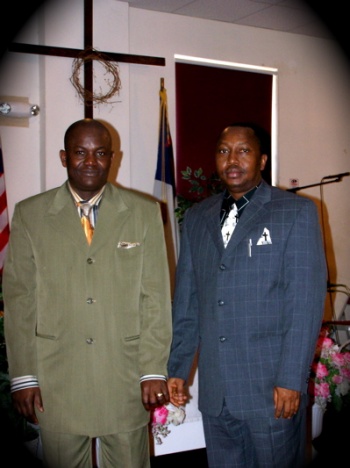Christassembly
From The Peopling of New York City
Christ Assembly
To the African immigrant community, church is like a second home. Here, they are able to worship God while still maintaining their strong sense of community which is necessary to a successful life in their new country. Christ Assembly Lutheran Church grew out of the African Immigrant Ministry of the Lutheran Church and has become an important cultural center for Afrian Immigrants in Staten Island. Here, Liberian, Nigerian, and Ghanaians living in Staten Island are able to interact with their brothers and sisters as they partake in traditional religious services.
Church is an escape from the challenges of the difficult adaptation immigrants must go through to assimilate into their new culture. It is a friendly and welcoming place that accepts all into their faith. Due to limited financial resources and the relative youth of the church, Christ Assembly holds its services in a non-traditional building. Although money is an issue, they are able to overcome their deficit with high spirits of hope. The services are filled with members of all ages, consisting mostly of women and children. Here, they gain support from their fellow members through family-like interactions. The sermons were upbeat, and inspirational, allowing members to participate in the song and dance that followed.
Below are some excerpts from our experiences at Christ Assembly Lutheran Church.
Reflections on our Church Visit
The church was not how we had imagined it. Made with red bricks and with only a banner indicating that it was the Christ Assembly Lutheran Church, from the outside, it looked like an odd mix between an apartment building and a department store. Inside we met up with Professor Rice and her husband. Together we entered where the service would be taking place.
We arrived promptly at 11:00 for the service, but because of the Sunday school, it was delayed a few minutes. We attempted to sit in the back row, so that we would not get in the way, but no sooner did I collapse into my seat, one of the older women asked us to get up and seat ourselves in the front row. It appeared that they were very proud of having visitors attend their church. They supplied us with songbooks, so that we could sing along with the choir and participate in the events that would be occurring throughout the service. -Robert
As we were seated, I began to scan the church, analyzing the décor as well as the people inside. The walls were a bland white, the windows had red curtains draped over them to keep out the sunlight, and one side of the room was a set up for a band. Both the music and the speakers were fairly loud. The band consisted of a keyboard, conga drums and a drum synthesizer that sounded like different types of drums at different times. The speakers were all very animated and demanded the audience’s attention and participation. The people in the church ranged from all ages. The women dressed in both African and American attire. The ones dressed in African attire covered their heads which is traditional in most parts of Africa. The majority of people present were women and children. The ministers, however, were all male.
-Professor Rice
The service started out just as any Christian service would, with the people reading responses from the handbook after the minister. Then, just as everything was going smoothly, a boisterous man stepped onto stage with his microphone and turned towards the choir, dressed in yellow gowns with purple sashes. They quickly broke out in song, aided by a band of instruments played by church members. Suddenly, everyone came to life, swaying, clapping, and singing to the beat. As we stood and clapped our hands, singing and moving along to the jovial rhythm, the elderly women began to move towards the stage and started dancing. They were all dressed in very traditional attire, which was very colorful and included a large, matching head cloth to be wrapped around their hair. They sang and danced as they praised the Lord, singing all his songs and shouting “Amen” to the heavens. This was the first but wouldn’t be the last time for such songs during the service.
-Richard
The service was an interesting cultural blend. It had elements of a reformed church service (the processional and recessional, traditional hymns, the prayer of confession and the assurance of absolution) mixed with very obvious African elements. The service deviated from the traditional Lutheran Church structure when they began Praise and Worship. This was probably the highlight of the service. The choir director and singers led the congregation in three praise songs and encouraged people to “dance before the Lord.” The only people that really danced were the older women, but everyone was moving in some way.
-Professor Rice
Then came the sermon and before us stood a calm and poised African man, obvious from his accent, in a suit. He started out slow and tranquil, increasing his tone and pitch from there on. The main theme of this specific service was to “Check yourself”. We were told to not use unnecessary violence towards other, either in warfare or in our own homes. We were taught that with the help of God, we could overcome our battles without aggression and hostility. -Richard
The people were very warm and welcoming… I noticed that the people of the Lutheran church get very involved in their song which I felt free to get involved in as well.
-Gary
Besides the feeling of wanting to bust out in song and dance, I also wanted to observe and witness the unity of a culture that we don't usually experience in our own time. I was able to witness that there are very strong cultural ties. The members greeted each other with embraces and handshakes, smiling and holding hand while worshiping. Upon entering we saw flags which would presume that the church caters to a number of these cultures. I wanted to witness the strong cultural ties within the church community and compare them to my own… Even though I am Hindu I was able to relate to the message that was being preached and I think that is important in order to foster a sense of community and unity.
-Suren


